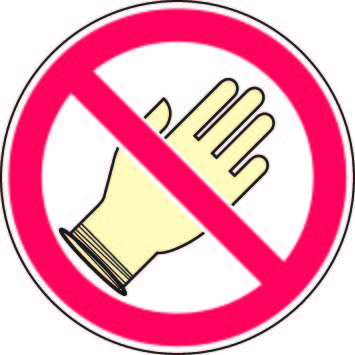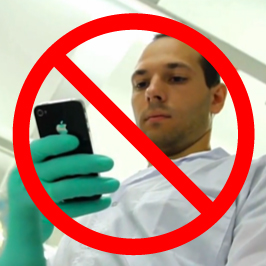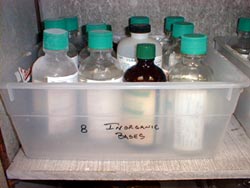Laboratory Safety
The chemical hygiene plan for UW can be found here and covers most topics for lab safety. There are certain important points that need special attention and are mentioned below. Please contact Tony with any safety questions or concerns.
Gloves and Lab Coats

Gloves must be removed before leaving the lab unless you are transporting chemicals, then ONE glove can be worn so that doorknobs, elevator buttons, etc. can be used by ungloved hand without contamination.
Gloves should be removed before touching anything that others would touch without gloves. This includes items within the lab that others may use (computers and equipment unless designated as for use with gloves, tools, etc.)
 Avoid using cell phones while wearing gloves, which can cause contamination after
you have left the lab.
Avoid using cell phones while wearing gloves, which can cause contamination after
you have left the lab.
Lab coats should be removed before leaving the lab if possible (if transporting chemicals, it is ok if necessary).
No lab coats allowed in offices.
Standard Operating Procedure (SOP) and Hazard Assessment Certification Form (HACF)
For all experiments performed, an SOP and HACF must be prepared and approved by Kyle
Winkelman, Dr. Jin, and Dr. Fan.
After preparing these two forms:
- Print out a hard copy and submit it to Kyle first
- After you have obtained Kyle’s approval, submit it to Dr. Jin for approval.
- Finally, submit it to Dr. Fan.
Once all three people have approved these forms, they should be placed in the SOP / HACF binder located in the lab.
Chemical Handling
Please refer to the chemical hygiene plan for more details on topics not covered here.
 Transport and handling of samples and chemicals
Transport and handling of samples and chemicals
Always use secondary containment when transporting chemicals or samples between labs. Each lab should have multiple transport containers, but if not, please let Ying know.
 Remember to label all sample containers. A proper label contains full chemical names,
chemical hazards, date, and initials of the responsible party.
Remember to label all sample containers. A proper label contains full chemical names,
chemical hazards, date, and initials of the responsible party.
Chemical Storage
When certain hazardous chemicals are stored or mixed together, violent reactions
may occur because the chemicals are unsuitable for mixing, or are incompatible. Classes
of incompatible chemicals should be segregated from each other during storage, according
to hazard class.
The chemical storage section in the chemical hygiene plan can be found in this chemical storage document.
Chemical Storage Chart
This is a chemical storage chart shows proper organization for chemical storage. This is a good guide for how to separate you chemicals. Ideally, each of these groups should be in their own cabinet, but if more than group is in the same cabinet or shelf, use secondary containment to separate the groups in case of spills. If you need additional containers, please contact Tony or Ying.
Chemical Waste
Chemicals should be stored according to hazard class (ex. flammables, oxidizers, health hazards/toxins, corrosives, etc.).
- Store chemicals away from direct sunlight or localized heat.
- All chemical containers should be properly labeled, dated upon receipt, and dated upon opening.
- Store hazardous chemicals below shoulder height of the shortest person working in the lab.
- Shelves should be painted or covered with chemical-resistant paint or chemical-resistant coating.
- Shelves should be secure and strong enough to hold chemicals being stored on them. Do not overload shelves.
- Personnel should be aware of the hazards associated with all hazardous materials.
- Separate solids from liquids.
Lab waste storage
All laboratory waste must be stored using approved waste containers and labeled using a hazardous waste label. In addition, all waste must have secondary containment.
- Waste containers (available from EHS) should be sturdy, plastic coated, routinely inspected for leaks and compatible with the waste. Keep containers closed when waste is not being added or removed.
- Waste should not be stored for more than 90 days from initial date of addition.
- Do not store incompatible waste chemicals in the same container.
Waste disposal
Requests for disposal of chemical waste must be submitted through the waste disposal
form found on the Environmental Health and Safety (EHS) website:
Hazardous waste disposal request form
Fill out the form as completely as possible. Required fields include: requester’s
name, department and principal investigator (PI; professor in charge of lab). Describe
the waste with the chemical names and percentages to the best of your knowledge. Unknowns
are very expensive to dispose of and it is illegal to transport them on public roads.
The more information we have the better.
Broken glass disposal
Do not put glassware in the garbage. Glass should be disposed of in a corrugated cardboard box. When full, tape up all openings so that no glass can escape, and take the box outside and put in a dumpster.
Ovens
Electrically heated ovens are commonly used in the laboratory to remove water or other solvents from chemical samples and to dry laboratory glassware. Never use laboratory ovens for human food preparation.
- To avoid explosion, glassware that has been rinsed with an organic solvent should be rinsed again with distilled water before being dried in an oven.
- Do not use paper or Parafilm in ovens.
- Ovens should not be used to dry any chemical sample that might pose a hazard because of acute or chronic toxicity unless special precautions have been taken to ensure continuous venting of the atmosphere inside the oven. If you need to dry your sample in this way, discuss it with Dr. Jin first.
- Various ovens (drying, high temperature) are located in 2025A.
Purchasing Supplies and Equipment
Purchasing of supplies, chemicals, equipment, etc. must be done through either Ying
or Dr. Jin. The preferred method is to find the product you want to purchase online
and send the link to either Ying or Dr. Jin with any necessary details.
Purchases from the chemical stockroom must be approved first by Ying or Dr. Jin.
Liquid Nitrogen
Liquid nitrogen is obtained from the chemical stockroom (Physical Science Building,
Room 20).
Be sure to only use the large freight elevator for transporting liquid nitrogen. A
spilled container of liquid nitrogen can push all of the oxygen from a small elevator.
Help from technicians
Kyle Winkleman (EN 3006) is the shop supervisor and is available to help us, but on
a limited basis. If you will need extensive help from him (for example – fabricating
a part) please ask Dr. Fan first.
There are also others in the department and on campus available to help us (electronics,
glass, fabrication, etc.) but this is not free so always ask Dr. Fan first.
Undergraduate Research
Undergraduate research is an opportunity for students to gain experience in performing research while learning experimental, computational, or theoretical skills. It is also an opportunity for students interested in graduate school and careers in research to experience first-hand the research process.
Undergraduate Student Expectations
Research credit hours are earned through working with a graduate student mentor on a research project.
- Undergraduate students registered for undergraduate research are expected to work at least 2 hours per week for every credit hour of research registered. For example, 3 credit hours of research = at least 6 hours of work per week.
- All undergraduate researchers are required to submit monthly reports to their mentor and to Dr. Fan. This means that in one semester, you are required to submit 3 reports to receive a passing grade.
- Grade (S/U) is determined by the quality of work performed, as well completion of required hours and assigned tasks.
Mentor Expectations
Mentors are required to keep track of hours worked, and reports submitted for each
undergraduate student working with them. Please mention the hours worked in your weekly
progress report.
Mentors should provide the opportunity for the students to be involved in different
aspects of the research. This could be some combination of running experiments, data
analysis, literature search, etc.

